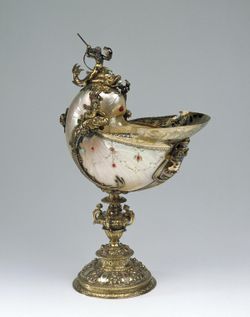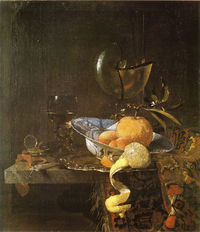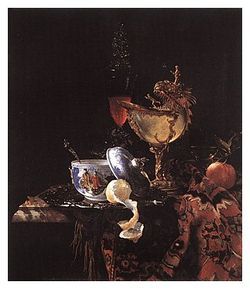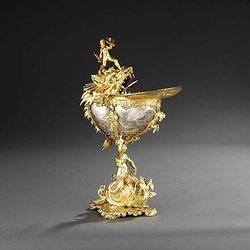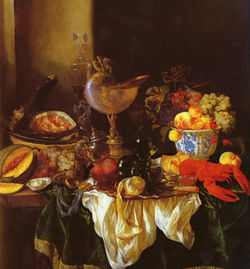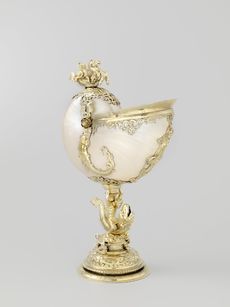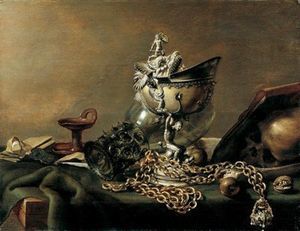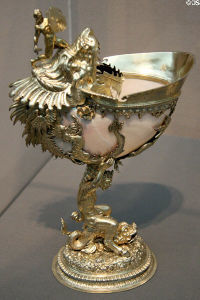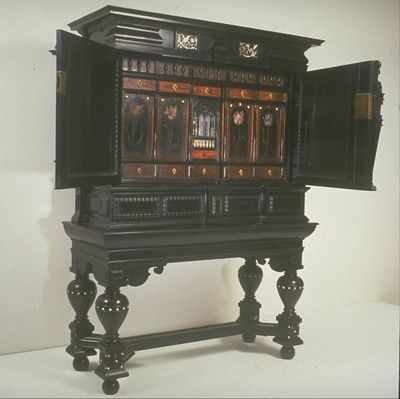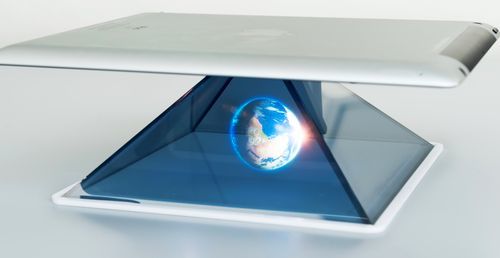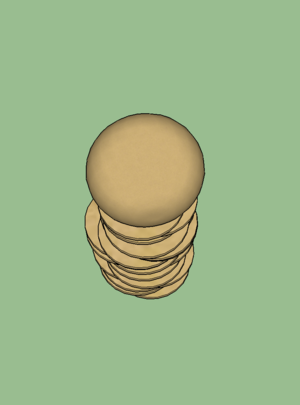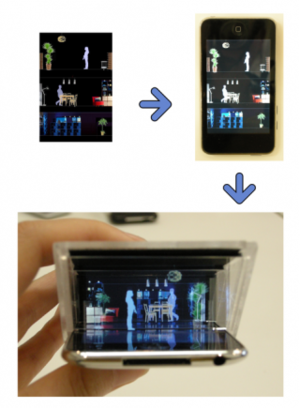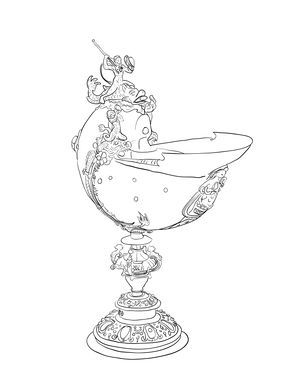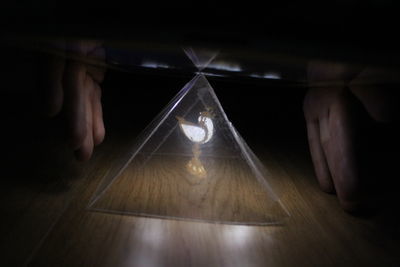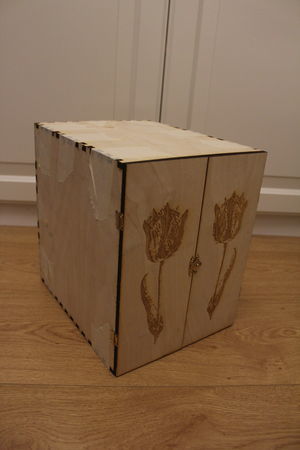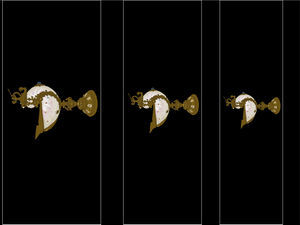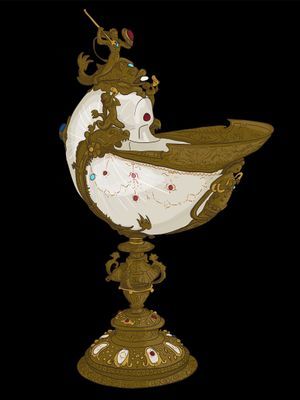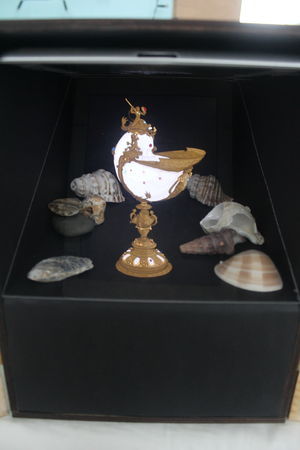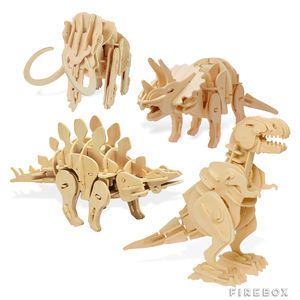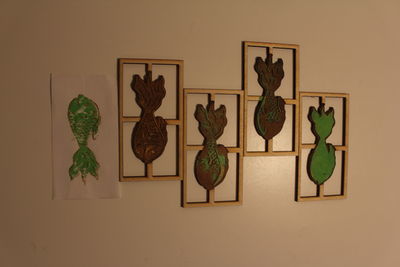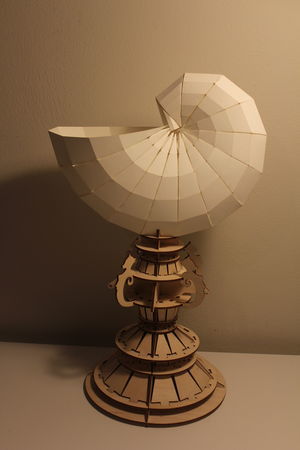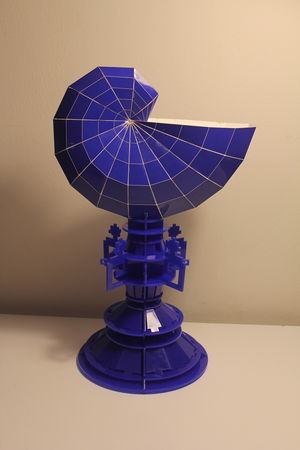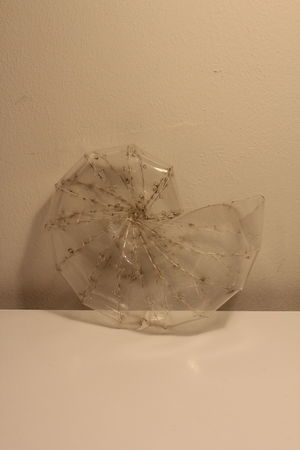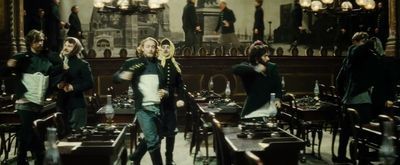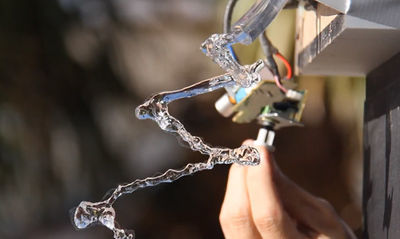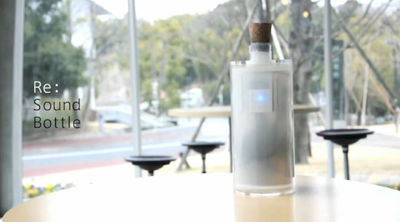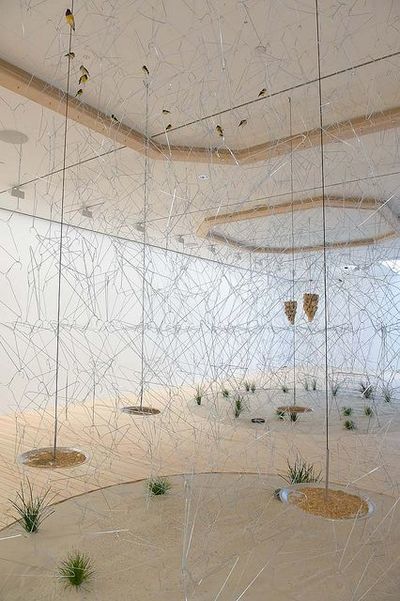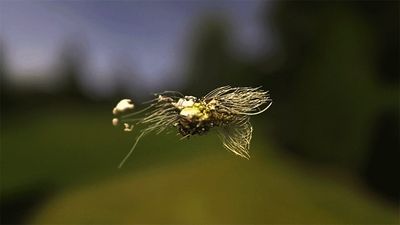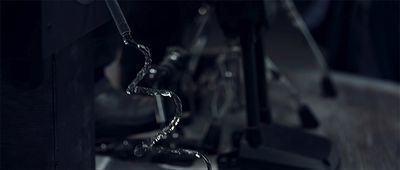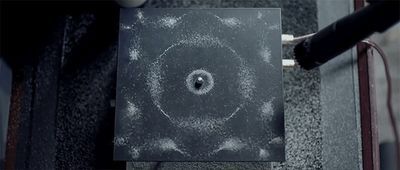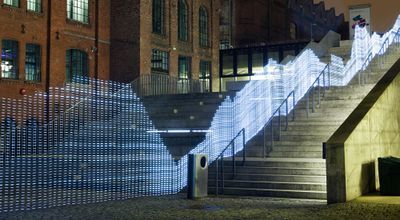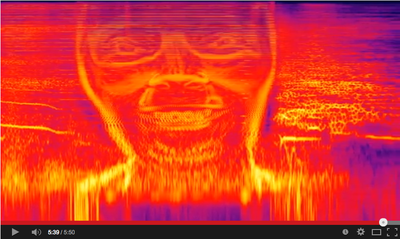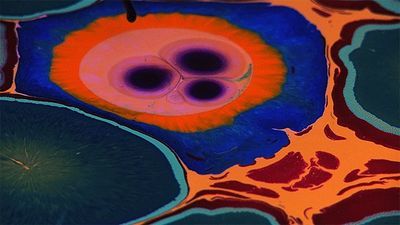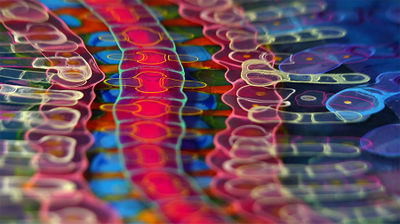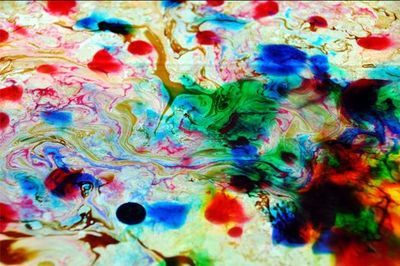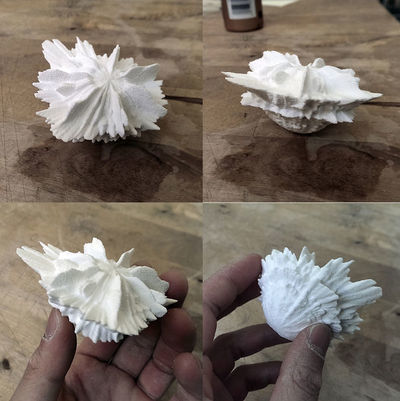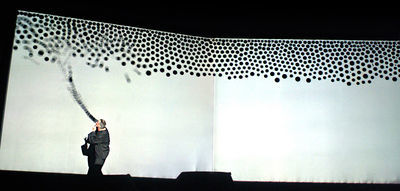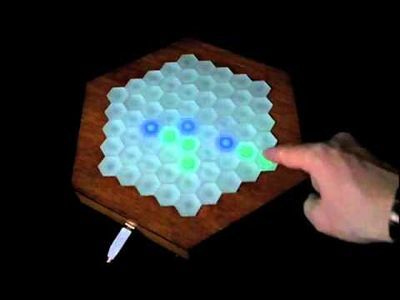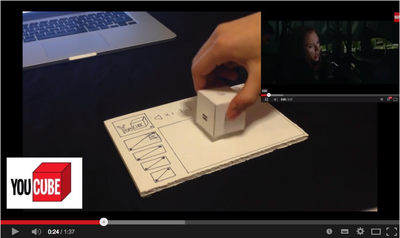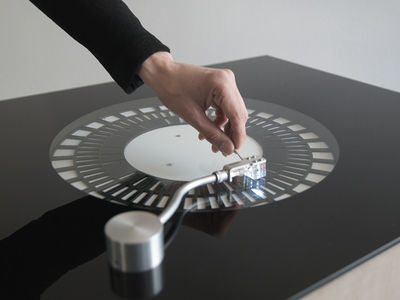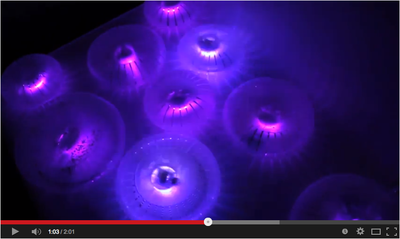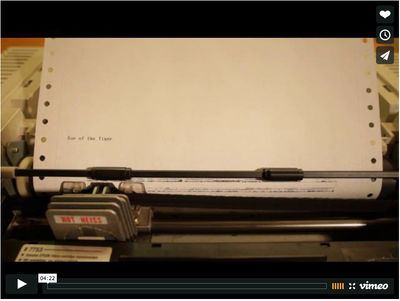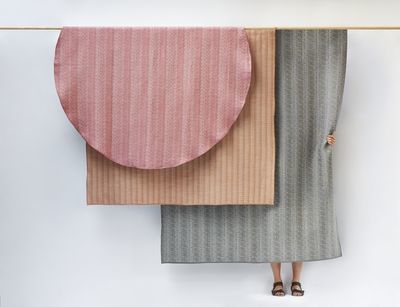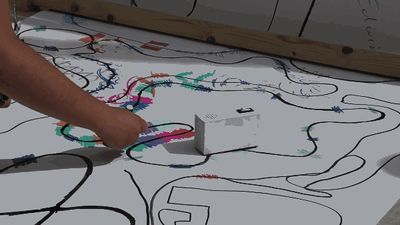Difference between revisions of "User:N.Everts"
| (37 intermediate revisions by the same user not shown) | |||
| Line 1: | Line 1: | ||
| − | + | ==Workshop== | |
| − | [http:// | + | |
| + | ==Project 1== | ||
| + | [[File:resolve.jpg|250px|thumb|Nautilus beaker, ca. 1590]] | ||
| + | |||
| + | As inspiration for my first project I took the nautilus beaker. It is made of nautilus shell, silver, gilting, mother-of-pearl and precious stones. I chose it because of the details. The use of natural materials and metals is rather intriguing, especially considering the era it's made in. It really looks like a prop from a fantasy movie of something along those lines. | ||
| + | |||
| + | ===Reseach=== | ||
| + | [[File:p1.jpg|200px]] | ||
| + | [[File:b1.jpg|150px]] | ||
| + | |||
| + | '''Beaker and Paintings''' | ||
| + | |||
| + | This beaker isn't the only one in existence though. There are quite a few others dating from the same era. The cups most likely originated from The Netherlands as most of them have the signs of either Rotterdam or Amsterdam or Delft on them. Though there are also a few pieces with marks from German. They are seen as pieces of art rather then just object because of their architectural earth. [http://www.jstor.org.ezproxy.hro.nl/stable/40381048?seq=1&Search=yes&searchText=nautilus&searchText=beker&list=hide&searchUri=%2Faction%2FdoBasicSearch%3FQuery%3Dnautilus%2Bbeker%26amp%3Bacc%3Don%26amp%3Bwc%3Don%26amp%3Bfc%3Doff&prevSearch=&resultsServiceName=null|''Een Hollandse Nautilusbeker'', Th. M. Duyvené de Wit-Klinkhamer] | ||
| + | Another thing that is quite interesting is the fact that the beakers appear in a few still life paintings dating from the renaissance. Most of them painted by Dutch painters, like for example Abraham van Beyeren and Willem Kalf. Though the paintings look a lot like the really cups but they are not completely identical. | ||
| + | |||
| + | [[File:p2.jpg|250px]] | ||
| + | [[File:b2.jpg|250px]] | ||
| + | |||
| + | |||
| + | |||
| + | [[File:p3.jpg|250px]] | ||
| + | [[File:b3.jpg|230px]] | ||
| + | |||
| + | A painting by Pieter Claesz is the only painting with which I was able to find a beaker that was almost completely identical though still isn’t a 100% the same. | ||
| + | |||
| + | [[File:p4.jpg|300px]] | ||
| + | [[File:b4.JPG|200px]] | ||
| + | |||
| + | '''Cabinets of Curiosities''' | ||
| + | |||
| + | Nautilus cups were (and continue to be) among the most prestigious trophy objects within silver collections, and as such they were frequently represented in still life paintings, such as those by Willem Claesz. Heda (Dutch, 1594 – c. 1670). But they are | ||
| + | particularly representative of the objects collected in the Renaissance ‘cabinets ofcuriosities,’ a type of collection, which is an important forerunner of the modern museum as an institution. Striving to put together the rarest and most exotic, wondrous products of nature with the most astonishing accomplishments of human inventiveness and dexterity, that is of naturalia and artificialia as they were called at the time, princes and the richest merchants of the 16th and 17th centuries put together the first large collections of zoological, botanical, and mineralogical specimens blended with the most exquisite works of art. These “cabinets of curiosities” were also known as Kunst- und Wunderkammern (“chambers of art and wonder”). They first emerged in the territory of the Holy Roman Empire and in central Europe, before spreading throughout the remainder of the continent. By combining natura and artificium in a single work, Nautilus cups can be seen as pars pro toto embodiments of the very concept of collecting that informed the “cabinets of curiosities” at large. | ||
| + | [http://www.artsjournal.com/realcleararts/wp/wp-content/uploads/2012/08/Nautilus-Cup.pdf| Artsjournal] | ||
| + | |||
| + | [[File:R1.jpg|400px]] | ||
| + | |||
| + | ===Inspiration=== | ||
| + | |||
| + | |||
| + | '''HOLHO''' | ||
| + | |||
| + | This is a device that lets you create holograms using a phone or tablet. The hologram is created by the 4 sides that reflected image, creating the illusion that the projected image is inside of the device. | ||
| + | [http://www.holhocollection.com/| HOLHO] | ||
| + | |||
| + | [[File:I4.jpg|500px]] | ||
| + | |||
| + | |||
| + | '''i3DG by Jitsuro Mase''' | ||
| + | |||
| + | i3DG is a playful analog extension to an iPhone or an iPodTouch, converting its 2D display into a layered 3D view. Using the old technique of placing a half-silvered mirror at a 45-degree angle in front of an image, in a new context, the project extends upon 3D displays and iPhones. As a peripheral gadget, i3DG can support a wide range of different applications, from 3D videos and animations to accelerometer-based games. | ||
| + | [http://www.creativeapplications.net/events/palm-top-theater-peppers-ghost-iphone-events/| i3DG] | ||
| + | |||
| + | [[File:I1.png|300px]] | ||
| + | [[File:I2.png|300px]] | ||
| + | [[File:I3.png|300px]] | ||
| + | |||
| + | |||
| + | ==Replica with different technique / material== | ||
| + | Modern illustration of the nautilus beaker, using Illustration and Wacom | ||
| + | (in progress) | ||
| + | |||
| + | [[File:Nautilus_beker-01.jpg|300px]] | ||
| + | |||
| + | I wanted to created a hologram using illustratons form all 4 sides of the object. | ||
| + | |||
| + | [[File:IMG_2005.JPG|400px]] | ||
| + | |||
| + | Though I had trouble with the light presenting my project during daytime. So I thought of a way to still be have the hologram clearly visible despite the amount of light in the room. I recreated a modern version of the cabinet of curiosities in which I could present the hologram. | ||
| + | |||
| + | [[File:IMG_2009.JPG|300px]] | ||
| + | |||
| + | I tried to create more depth by using the i3DG technic but the images came out to small and barely visible to I decides just to use 1 layer. | ||
| + | |||
| + | [[File:ipad_image1.jpg|300px]] | ||
| + | [[File:ipad_image_af-01.jpg|300px]] | ||
| + | |||
| + | In the end my replica became a sort of collaboration between the usual representation of a nautilus beaker in the renaissance, either resented in a cabinet of curiosities of captured in a still life painting. My replica is a modern captured images placed in its cabinet, which are both made with modern technologies. | ||
| + | |||
| + | [[File:Foto1.JPG|300px]] | ||
| + | |||
| + | Though it still didn’t have enough depth so I tried creating depth by putting stuff inside the box and animating the image, but nothing really created the effect that I wanted. Then I thought of the image itself and how it is build up out of layers, and maybe I could do something with that. I could take all the layers apart and make stamps of them, so that you could easily recreate the image again. I made a little test, but I didn’t turn out the way I thought it would. I had to go a step further. So I decided to completely let go of my previous idea and started thinking in a different way. I had to create something in 3d. That’s how I came up with the idea off the “puzzle”. As an inspiration I had those dinosaurs that you could have as a child, which you could push out of a flat piece of wood or cardboard and build up into a 3 dimensional dinosaur. So I decided to build my own model like that. I also came up with a model to create the shell from just a flat piece of paper. And for my interpretation I went on with the replica I had and created another version that had a complete different look and sensation to it. For the last one I wanted to make a transparent version using the outline from the previous version as a mould to pour resin in. In the end I decided that the mould would work better as a whole piece and as a blueprint of the work I created. | ||
| + | |||
| + | |||
| + | [[File:Dino.jpg|300px]] | ||
| + | |||
| + | |||
| + | [[File:F6.JPG|400px]] | ||
| + | |||
| + | |||
| + | [[File:Foto2.JPG|300px]] | ||
| + | [[File:F3.JPG|300px]] | ||
| + | [[File:F4.JPG|300px]] | ||
| + | |||
| + | |||
| + | [[File:F5.JPG|400px]] | ||
| + | |||
| + | |||
| + | ===Insperation=== | ||
| + | '''Hermit Crab Shell by Aki Inomata''' | ||
| + | |||
| + | The idea I came up with was inspired by a work I had seen recently by the Japanese artist Aki Inomata. For this work she 3D printed shells for hermit crabs using a clear plastic. She decorated the tops of the shells with architectural sceneries inspired by places all over the world. | ||
| + | [http://www.boredpanda.com/3d-printed-hermit-crab-shells-architecture-aki-inomata/| Aki Inomata] | ||
| + | |||
| + | ==Written Assignment== | ||
| + | I am a visual artist. I create stories, impressions, sceneries, feelings, and emotions using audio and visual media. I have learned about the technical and the conceptual aspects of this craft. Though the thing with audio-visual work is that most of the time there are different disciplines in creating the pieces, practiced by different people with their experience of this particular discipline. In my time here at school I’ve work in a few of these disciplines; camera, sound, editing, colour grading, scenario, but I’ve experiences that I like working in the visualising of a concept the most, in a matter of art department. I like to create the right atmosphere and sensation for the story that’s been told. This is also the discipline I want to develop myself further in. | ||
| + | |||
| + | As a visual artist there are quite a few different tools and media that come along with it. You need lamps, cameras, lenses, filters, microphones, recorders, but also the software to put your material together and fine-tune them. There are also a lot of different media in which the video’s can be shown; think of cinemas, the internet, smartphones or just any television at home. However these tools and media are always developing. Video gets high resolutions and editing programs become more convenient. Also the media broadens and social media starts to play an important part in presenting and promoting your work. And as visual artist you have to adapt to these changes and new ways in order to pursue you’re work and keep it “up to date”. Unless you actually choose to work with or in old ways, like with analogue film for example. If it is from importance to your video, to create a certain feel or vibe to your film or for some astatic reason, it might be better to go with the old ways instead of all the new innovations. | ||
| + | |||
| + | However the art department is also gone though some chances. Back in the days film sets would just physically be build and the actors would be set into the décor. Now a days it sometimes works in a different way. Actors will act in front of a green screen and later on in the process the sets will be digitally built around them. This however does have some effect on the task of the production designer. There is no need to go out and get all the stuff to build the whole set anymore; cause a computer has replaced it. Although this doesn’t mean that the production designer is no longer needed, cause there is still a set that needs to be created. Even so it might even mean that it makes the production designers task more difficult, as for everything has to be created from scratch. | ||
| + | |||
| + | There are a lot of different ways to work as a production designer. You’ve got just the basic decorations of rooms or the creation of a fantastical landscape. But there also little tricks in which the set starts to play an active roll in de story. A very good example for instance is the work of Georges Méliès. He was one of the first filmmakers who manipulated his films with little tricks, like stop motion for example. His set played a very important part in creating these illusions. Things would disappear or reappear and the actors collaborated with their surroundings. I think that is a very clever and innovative way of making sets. | ||
| + | Another contemporary production designer I find very inspiring is Sarah Greenwood. She came up with the set for Joe Wrights Anna Karenina (2012). This is, just like Méliès work, a very dynamic stage, that is constantly changing. Though other then Méliès work, were the camera would be stop to make the changes and started again so that it would look like things would happen out of nowhere, Greenwoods work changes whilst the camera is still rolling. There is this one scene were a room filled decks turns into a cheque corner of a dining room while the camera is following the actors and everything is shot in one take even though it takes quite a while for everything to changes from the one scene into the other. It also has a bit of a theatrical feel to it, which I also find a very strong asset to the scene. | ||
| + | |||
| + | [[File:A1.jpg|400px]] | ||
| + | [[File:A2.jpg|400px]] | ||
| + | |||
| + | For my own work I find that atmospheres and vibes play an imported roll. And I believe that the power to really get a scene right lies within the colour, details and the things that actually most of the time goes unseen by the spectators. This is where the key lays to really creating the right “sfeer”. Brendan Dawes has created Cinema Rex in 2004 in which he as put all the frames of a movie next to each other and in this way creates a visual fingerprint of an entire movie. In this work you can also see the colour spectrum of a movie. Some seem bit browner tinted, others look a bit bluer. While just watching the movie as its self you might not really realise this, but when everything put together like this, it is much easier to notice it. In one glance you might even get a sense of the feel of the movie. [http://brendandawes.com/projects/cinemaredux| Brendan Dawes] | ||
| + | |||
| + | I am still trying to find my own signature in creating set, atmospheres, ambient and ways of telling a story with visuals, but I’m hoping that with this minor I will also find a new and unique way to accomplice this. To find a balance between the new innovations and the classic ways of achieving a set that would tell you the story even without the story of the movie itself. | ||
| + | |||
| + | |||
| + | ==Project 2== | ||
| + | |||
| + | [http://www.thisiscolossal.com/2013/03/this-is-what-happens-when-you-run-water-through-a-24hz-sine-wave/| Waterspiraal] | ||
| + | |||
| + | [[File:18-12-14_afb1.jpg|400px]] | ||
| + | |||
| + | |||
| + | |||
| + | [http://www.thisiscolossal.com/2013/06/artist-lisa-park-manipulates-water-with-her-brain/| Beautiful Thoughts: Artist Lisa Park Manipulates Water with Her Mind] | ||
| + | |||
| + | [[File:18-12-14_afb2.jpg|400px]] | ||
| + | |||
| + | |||
| + | |||
| + | [http://www.thisiscolossal.com/2014/11/a-new-acoustic-instrument-that-creates-sounds-like-a-digital-synthesizer/| A New Acoustic Instrument That Creates Sounds like a Digital Synthesizer] | ||
| + | |||
| + | [[File:18-12-14_afb3.jpg|400px]] | ||
| + | |||
| + | |||
| + | |||
| + | [http://www.thisiscolossal.com/2012/12/re-sound-bottle-by-jun-fujiwara/| Collect Sounds Like Fireflies in the ‘Re: Sound Bottle,’ a Device that Creates Your Own Personal Soundtrack] | ||
| + | |||
| + | [[File:18-12-14_afb4.jpg|400px]] | ||
| + | |||
| + | |||
| + | |||
| + | [https://www.youtube.com/watch?v=OC2osbm-ZF0| Céleste Boursier-Mougenot | 'From here to ear (v. 13)' 2010] | ||
| + | |||
| + | [[File:18-12-14_afb5.jpg|400px]] | ||
| + | |||
| + | |||
| + | |||
| + | [http://www.thisiscolossal.com/2014/08/audio-life-forms-andy-thomas/| Artist Creates Digital Life-Forms that Respond to Archival Birdsongs] | ||
| + | |||
| + | [[File:18-12-14_afb6.jpg|400px]] | ||
| + | |||
| + | |||
| + | |||
| + | [http://www.thisiscolossal.com/2014/11/cymatics-new-music-video-for-nigel-stanford-merges-music-and-science-experiments/| Cymatics: New Music Video for Nigel Stanford Merges Music and Science Experiments] | ||
| + | |||
| + | [[File:18-12-14_afb7.jpg|400px]] | ||
| + | [[File:18-12-14_afb8.jpg|400px]] | ||
| + | |||
| + | |||
| + | |||
| + | https://vimeo.com/20412632| Immaterials: Light painting WiFi] | ||
| + | |||
| + | [[File:18-12-14_afb9.jpg|400px]] | ||
| + | |||
| + | |||
| + | |||
| + | [https://www.youtube.com/watch?v=W4KKjs3iETQ| Black MIDI - Synthesia - History of the Moon 580,000 note remix 60 FPS] | ||
| + | |||
| + | [[File:18-12-14_afb10.png|400px]] | ||
| + | |||
| + | |||
| + | |||
| + | [https://www.youtube.com/watch?v=wSYAZnQmffg| Spectrogram - Aphex Twin / ΔMi−1] | ||
| + | |||
| + | |||
| + | |||
| + | [http://www.thisiscolossal.com/2014/11/psychedelic-poured-paint-and-resin-paintings-by-bruce-riley/| Psychedelic Paint and Poured Resin Artworks by Bruce Riley] | ||
| + | |||
| + | [[File:18-12-14_afb11.jpg|400px]] | ||
| + | [[File:18-12-14_afb12.jpg|400px]] | ||
| + | |||
| + | |||
| + | |||
| + | [http://www.instructables.com/id/Paint-Pulse-Digital-Water-Marbling/| Paint Pulse: Digital Water Marbling] | ||
| + | |||
| + | [[File:18-12-14_afb13.jpg|400px]] | ||
| + | |||
| + | |||
| + | |||
| + | [http://www.instructables.com/id/Sound-Fruit-How-to-Make-a-Sculptural-Audio-Visuali/| Sound Fruit - How to Make a Sculptural Audio Visualizer] | ||
| + | |||
| + | [[File:18-12-14_afb14.jpg|400px]] | ||
| + | |||
| + | |||
| + | |||
| + | [https://vimeo.com/8012159| Clavilux 2000 - Interactive instrument for generative music visualization] | ||
| + | |||
| + | [[File:18-12-14_afb15.png|400px]] | ||
| + | |||
| + | |||
| + | |||
| + | [https://www.youtube.com/watch?v=GfoqiyB1ndE| Jaap Blonk - installation Messa di Voce] | ||
| + | |||
| + | [[File:18-12-14_afb16.jpg|400px]] | ||
| + | |||
| + | |||
| + | |||
| + | [https://www.youtube.com/watch?v=PmFeiIFhiOw| Mike Cook - Hexome, Tangible Music Interface 2011] | ||
| + | |||
| + | [[File:18-12-14_afb17.jpg|400px]] | ||
| + | |||
| + | |||
| + | |||
| + | [https://www.youtube.com/watch?v=7JWutrp3Zh4| Shaping Sounds -- A Vision for Tangible Music Interaction] | ||
| + | |||
| + | [[File:18-12-14_afb18.png|400px]] | ||
| + | |||
| + | |||
| + | [http://www.creativeapplications.net/processing/soundmachines-objects-sound/| Soundmachines] | ||
| + | |||
| + | [[File:18-12-14_afb19.jpg|400px]] | ||
| + | |||
| + | |||
| + | [https://www.youtube.com/watch?v=IXZWyKz2voI| ChoreoBots: a tangible music visualization platform] | ||
| + | |||
| + | [[File:18-12-14_afb20.png|400px]] | ||
| + | |||
| + | |||
| + | |||
| + | [http://www.instructables.com/id/Build-an-LED-Display-That-Responds-To-Music/?ALLSTEPS| Build an LED Display That Responds To Music] | ||
| + | |||
| + | [[File:18-12-14_afb21.jpg|400px]] | ||
| + | |||
| + | |||
| + | |||
| + | [http://www.thisiscolossal.com/2014/02/old-tech-making-music/| Old Technology Making Music: ‘Eye of the Tiger’ on a Dot Matrix Printer and ‘Tainted Love’ Played on Hard Drives] | ||
| + | |||
| + | [[File:18-12-14_afb22.png|400px]] | ||
| + | |||
| + | |||
| + | |||
| + | [http://www.glithero.com/woven-songs| Woven Songs] | ||
| + | |||
| + | [[File:18-12-14_afb23.jpg|400px]] | ||
| + | |||
| + | |||
| + | |||
| + | [http://www.spoon-tamago.com/2014/12/04/color-chasers-yuri-suzuki-robots-color-into-sound/| Meet the Color Chasers, Yuri Suzuki’s Robots That Translate Colors Into Sounds] | ||
| + | |||
| + | [[File:18-12-14_afb24.jpg|400px]] | ||
| + | |||
| + | ===Tools of the trade=== | ||
| + | [[File:Tools_of_the_trade_pdf.pdf]] | ||
| + | |||
| + | Nowadays, almost everything has to digital. You can barely go through a day without being in contact with something digital at least once. Better yet, the very first thing you’ll be in contact with on a day will probably be your alarm clock or the alarm on your mobile phone waking you up. Electronics are slowly replacing all kinds of things; you can read the paper on your tablet, you talk to your friends on the phone and even cars are now being built so that they can park themselves. But not only the things we use are becoming digital, also the things to create with are becoming digital. You can model a shape, send it to the 3D-printer and within a few hours time you will be able to hold your modelled shape in your hands. Everything is becoming easier and more convenient. Electronic instruments are programmed to do all the calculations and translate your input in order to create the thing you desire. | ||
| + | |||
| + | Also, everything becomes more equipped and gets a wider range of functions and options. Take for example the mobile phone. The main purpose of it was to have a portable phone so that you would be able to call someone from wherever you are. Though now it also comes with games and a camera and you can listen to music and check your email. So not only are a lot of things becoming digital, the already digitalised objects themselves are also still evolving and becoming more advanced. | ||
| + | |||
| + | |||
| + | For my project I decided to take something analogue and turn it into something digital and even try to enhance it. To stay in my theme of choice, audio to visual, I took the music box as my starting point for the audio part. A nice little instrument that found its origin in the early 19th century. It consists of a cylinder with little pins on it that brushes against a little metal comb with tunes teeth cut out in different lengths while spinning the cylinder, creating a range of tones that will sound the melody. A few of the earlier models used to have a disc with little holes in them to generate the tones. Another close related instrument to the music box is the barrel organ. It either operates with a cylinder like the one from the music box or with an organ book, which are cardboard shades with stripe-like holes in them. | ||
| + | |||
| + | For my music box I started thinking on how I was going to generate my sounds in a digital way. I wanted to work with the organ book idea, so I had to find a way to ready the stripes and gaps. So I decided to use light sensors. The paper would slide over the sensors and once the light would hit the sensor through one of the gaps you would be able to hear the tone. To achieve this, I wrote a script that would be sent to an Arduino, which would activate the system. After the base was set, I could start and look in which way I could improve my digital music box and create the visual aspect of my theme. I started playing around with it and notices that by just waving your hand above the sensors it would create odd and random kind of melodies, but you would also be able to control which note would be heard and you could start jamming with it. That’s when I came with the idea to ‘write down’ the music while you’re playing it so you could read back and save what you just played. So for the visual part of my theme I decided I would print the notes in the way that is used in the organ books. The sensors are linked to servos which have markers attached to them, so that once a sensor would be activated you would hear the note and at the same time the servo will set the marker down on a piece of paper, that will be rolled through the box by using a little motor, and create the stripe that represents the note. Each sensor has their own note therefore their own servo and marker. So while playing your song the notation of it will come rolling out of the box. | ||
| + | |||
| + | And just as with a music box, all the mechanics are hidden away inside the box. The only things that are visible are the sensors and the slot where eventually the paper will roll out off. This will keep some mystery to it and people will have to come and try it out for them selves in order to see what the box does. | ||
| + | |||
| + | So now I have created my new and improved digital music box, which lets you create your own tunes and at the same time make a print of this. But now my question really is; is it really that much better then the original or is it not even better at all? | ||
| + | |||
| + | |||
| + | This brings me to the main core of my project; is it really necessary and better to turn everything into electronic and digital devices? I personally have this love-hate relationship towards everything electronic. On the one hand I can’t go without it, I even so much as rely on it. I need my laptop and my camera and all the software in order to work within my discipline. I need the Internet to do my research on for school projects. I need my phone to stay up to date about changes in schedules of to arranged meetings. I basically wouldn’t be where I am today without it. It has even come to a point where you barely can even avoid it anymore. You have to digitally check in for the train, you have use you debit card if you want to pay or get cash from the ATM, you can’t even go into a grocery store without having the doors automatically open for you. But I do find it fascinating. I for example loved making the music box and figuring out where which wire should go and trying to write the right script in order to make it work. It is amazing to see how much is possible today and how fast it is developing. | ||
| + | |||
| + | But at the same time this scares me. What would the world look like in a few decades? Will it all be machinery and flickering light, where there is barely any human interaction left? I mean look at us now; we can’t go a day without our phones. Go to any arbitrarily, slightly crowed train station, park, square or even café or bar and it would be a miracle if you would not see even one person on their phone. And I know, I’m guilty of this behaviour too but sometimes do wish it wasn’t that way. Sometimes I wish we would still live in a world without all these developments, where train tickets were still nicely print on a piece of paper, where coffee would still be made with a coffee grinder, where you still had to do the pushing yourself in a revolving door or that we would even still only used candles for light. Okay maybe the last one might be a bit extreme, but still. And I know these are just small things, but a lot of small things make a big thing. These old little things romanticised the world a bit more, kept it a bit more human instead of this cold society driven by electronic equipment’s. And for some of the developments I’m even wondering why it would even exist or be necessary at all. Why would you want a washing machine with a wifi connection so you can turn it when your not at home?! Okay yeah so you can time when it turns on so it will be done at the very same second as you get home so you can take it out straight away. But why! Is it really such a problem that if you put your clothes in, turn it on right away, leave, come back and it will have been done for a couple of hours? It’s not like it will decide to eat it if you do not take it out within 10 minutes after it has given you the sign that he is done. Or why would you need a heart rate sensor on your phone or a toothbrush with a internet connection so it can show your statistics of how you are brushing your teeth and what you’re doing wrong? Everything has to become more extensive, just so it can be ‘more’ and better to climb up in the market, because for some reason this is what people want. | ||
| + | |||
| + | |||
| + | And maybe that is exactly the point; things need to evolve. Everything. I mean the very core of life is evolving. Without evolution we wouldn’t be where we are today. And maybe this rule is the same for electronic equipment. Whether you want it or not, things will grow and change, because everyday we’re learning more and more about these techniques. And some things are actually getting better for a good cause. Take for example the equipment in hospitals. We have been able to save so many lives due to the evolutions in electronic technologies. But also the quality of education has improved because of it. Or think of another important aspect like entertainment. Movies are getting bigger and more impressive. There are all these virtual reality systems being developed and games are getting more depth and can even be played without using any controllers. I think life would also get rather boring without all these technologies and developments. | ||
| + | |||
| + | But also for the art industry it is important to have all these techniques. It comes with a new form of creativity, new ways to create and new ways to think. Like I said earlier on, my discipline, audio-visual design, wouldn’t be the same without the digitalisation of equipment, footage and post-production techniques. It has become such a crucial part of the practise that you almost can’t go back to the old ways, also because people keep expecting more and better results. | ||
| + | |||
| + | |||
| + | So as you can see I’m quite torn between my idea’s of things becoming digital. Is it better to keep things the way they are to keep it ‘more human’ or is it actually better to let thing evolve so it stays up-to-date and give better results? And the same goes for crafting, is it better to keep craftsmanship or to get digital equipment involved? And this is what I want to achieve with my project, letting people think about this concept. I took the music box, digitalised it, gave it extra functions and in this way I let it evolve. It could even become more extensive, so it could be used as a tool by musicians to create and capture their songs and jam sessions. If you adapt it even more you could create a now kind of audio-visual instrument out of it. But now the question is, which one do you think is better? The new thing or the old little music box which could be thought of as authentic and romantic? Or maybe we have to find a way to create the right balance between them, of analogue and digital, digital and craft. Maybe that way the world can still evolve but won’t be overruled by technologies and keep its authenticity. | ||
| + | |||
| + | ==Aantekeningen== | ||
| + | [[/aantekeningen | mijn aantekeningen]] | ||
Latest revision as of 17:24, 21 December 2014
Contents
Workshop
Project 1
As inspiration for my first project I took the nautilus beaker. It is made of nautilus shell, silver, gilting, mother-of-pearl and precious stones. I chose it because of the details. The use of natural materials and metals is rather intriguing, especially considering the era it's made in. It really looks like a prop from a fantasy movie of something along those lines.
Reseach
Beaker and Paintings
This beaker isn't the only one in existence though. There are quite a few others dating from the same era. The cups most likely originated from The Netherlands as most of them have the signs of either Rotterdam or Amsterdam or Delft on them. Though there are also a few pieces with marks from German. They are seen as pieces of art rather then just object because of their architectural earth. Een Hollandse Nautilusbeker, Th. M. Duyvené de Wit-Klinkhamer Another thing that is quite interesting is the fact that the beakers appear in a few still life paintings dating from the renaissance. Most of them painted by Dutch painters, like for example Abraham van Beyeren and Willem Kalf. Though the paintings look a lot like the really cups but they are not completely identical.
A painting by Pieter Claesz is the only painting with which I was able to find a beaker that was almost completely identical though still isn’t a 100% the same.
Cabinets of Curiosities
Nautilus cups were (and continue to be) among the most prestigious trophy objects within silver collections, and as such they were frequently represented in still life paintings, such as those by Willem Claesz. Heda (Dutch, 1594 – c. 1670). But they are particularly representative of the objects collected in the Renaissance ‘cabinets ofcuriosities,’ a type of collection, which is an important forerunner of the modern museum as an institution. Striving to put together the rarest and most exotic, wondrous products of nature with the most astonishing accomplishments of human inventiveness and dexterity, that is of naturalia and artificialia as they were called at the time, princes and the richest merchants of the 16th and 17th centuries put together the first large collections of zoological, botanical, and mineralogical specimens blended with the most exquisite works of art. These “cabinets of curiosities” were also known as Kunst- und Wunderkammern (“chambers of art and wonder”). They first emerged in the territory of the Holy Roman Empire and in central Europe, before spreading throughout the remainder of the continent. By combining natura and artificium in a single work, Nautilus cups can be seen as pars pro toto embodiments of the very concept of collecting that informed the “cabinets of curiosities” at large. Artsjournal
Inspiration
HOLHO
This is a device that lets you create holograms using a phone or tablet. The hologram is created by the 4 sides that reflected image, creating the illusion that the projected image is inside of the device. HOLHO
i3DG by Jitsuro Mase
i3DG is a playful analog extension to an iPhone or an iPodTouch, converting its 2D display into a layered 3D view. Using the old technique of placing a half-silvered mirror at a 45-degree angle in front of an image, in a new context, the project extends upon 3D displays and iPhones. As a peripheral gadget, i3DG can support a wide range of different applications, from 3D videos and animations to accelerometer-based games. i3DG
Replica with different technique / material
Modern illustration of the nautilus beaker, using Illustration and Wacom (in progress)
I wanted to created a hologram using illustratons form all 4 sides of the object.
Though I had trouble with the light presenting my project during daytime. So I thought of a way to still be have the hologram clearly visible despite the amount of light in the room. I recreated a modern version of the cabinet of curiosities in which I could present the hologram.
I tried to create more depth by using the i3DG technic but the images came out to small and barely visible to I decides just to use 1 layer.
In the end my replica became a sort of collaboration between the usual representation of a nautilus beaker in the renaissance, either resented in a cabinet of curiosities of captured in a still life painting. My replica is a modern captured images placed in its cabinet, which are both made with modern technologies.
Though it still didn’t have enough depth so I tried creating depth by putting stuff inside the box and animating the image, but nothing really created the effect that I wanted. Then I thought of the image itself and how it is build up out of layers, and maybe I could do something with that. I could take all the layers apart and make stamps of them, so that you could easily recreate the image again. I made a little test, but I didn’t turn out the way I thought it would. I had to go a step further. So I decided to completely let go of my previous idea and started thinking in a different way. I had to create something in 3d. That’s how I came up with the idea off the “puzzle”. As an inspiration I had those dinosaurs that you could have as a child, which you could push out of a flat piece of wood or cardboard and build up into a 3 dimensional dinosaur. So I decided to build my own model like that. I also came up with a model to create the shell from just a flat piece of paper. And for my interpretation I went on with the replica I had and created another version that had a complete different look and sensation to it. For the last one I wanted to make a transparent version using the outline from the previous version as a mould to pour resin in. In the end I decided that the mould would work better as a whole piece and as a blueprint of the work I created.
Insperation
Hermit Crab Shell by Aki Inomata
The idea I came up with was inspired by a work I had seen recently by the Japanese artist Aki Inomata. For this work she 3D printed shells for hermit crabs using a clear plastic. She decorated the tops of the shells with architectural sceneries inspired by places all over the world. Aki Inomata
Written Assignment
I am a visual artist. I create stories, impressions, sceneries, feelings, and emotions using audio and visual media. I have learned about the technical and the conceptual aspects of this craft. Though the thing with audio-visual work is that most of the time there are different disciplines in creating the pieces, practiced by different people with their experience of this particular discipline. In my time here at school I’ve work in a few of these disciplines; camera, sound, editing, colour grading, scenario, but I’ve experiences that I like working in the visualising of a concept the most, in a matter of art department. I like to create the right atmosphere and sensation for the story that’s been told. This is also the discipline I want to develop myself further in.
As a visual artist there are quite a few different tools and media that come along with it. You need lamps, cameras, lenses, filters, microphones, recorders, but also the software to put your material together and fine-tune them. There are also a lot of different media in which the video’s can be shown; think of cinemas, the internet, smartphones or just any television at home. However these tools and media are always developing. Video gets high resolutions and editing programs become more convenient. Also the media broadens and social media starts to play an important part in presenting and promoting your work. And as visual artist you have to adapt to these changes and new ways in order to pursue you’re work and keep it “up to date”. Unless you actually choose to work with or in old ways, like with analogue film for example. If it is from importance to your video, to create a certain feel or vibe to your film or for some astatic reason, it might be better to go with the old ways instead of all the new innovations.
However the art department is also gone though some chances. Back in the days film sets would just physically be build and the actors would be set into the décor. Now a days it sometimes works in a different way. Actors will act in front of a green screen and later on in the process the sets will be digitally built around them. This however does have some effect on the task of the production designer. There is no need to go out and get all the stuff to build the whole set anymore; cause a computer has replaced it. Although this doesn’t mean that the production designer is no longer needed, cause there is still a set that needs to be created. Even so it might even mean that it makes the production designers task more difficult, as for everything has to be created from scratch.
There are a lot of different ways to work as a production designer. You’ve got just the basic decorations of rooms or the creation of a fantastical landscape. But there also little tricks in which the set starts to play an active roll in de story. A very good example for instance is the work of Georges Méliès. He was one of the first filmmakers who manipulated his films with little tricks, like stop motion for example. His set played a very important part in creating these illusions. Things would disappear or reappear and the actors collaborated with their surroundings. I think that is a very clever and innovative way of making sets. Another contemporary production designer I find very inspiring is Sarah Greenwood. She came up with the set for Joe Wrights Anna Karenina (2012). This is, just like Méliès work, a very dynamic stage, that is constantly changing. Though other then Méliès work, were the camera would be stop to make the changes and started again so that it would look like things would happen out of nowhere, Greenwoods work changes whilst the camera is still rolling. There is this one scene were a room filled decks turns into a cheque corner of a dining room while the camera is following the actors and everything is shot in one take even though it takes quite a while for everything to changes from the one scene into the other. It also has a bit of a theatrical feel to it, which I also find a very strong asset to the scene.
For my own work I find that atmospheres and vibes play an imported roll. And I believe that the power to really get a scene right lies within the colour, details and the things that actually most of the time goes unseen by the spectators. This is where the key lays to really creating the right “sfeer”. Brendan Dawes has created Cinema Rex in 2004 in which he as put all the frames of a movie next to each other and in this way creates a visual fingerprint of an entire movie. In this work you can also see the colour spectrum of a movie. Some seem bit browner tinted, others look a bit bluer. While just watching the movie as its self you might not really realise this, but when everything put together like this, it is much easier to notice it. In one glance you might even get a sense of the feel of the movie. Brendan Dawes
I am still trying to find my own signature in creating set, atmospheres, ambient and ways of telling a story with visuals, but I’m hoping that with this minor I will also find a new and unique way to accomplice this. To find a balance between the new innovations and the classic ways of achieving a set that would tell you the story even without the story of the movie itself.
Project 2
Beautiful Thoughts: Artist Lisa Park Manipulates Water with Her Mind
A New Acoustic Instrument That Creates Sounds like a Digital Synthesizer
Céleste Boursier-Mougenot | 'From here to ear (v. 13)' 2010
Artist Creates Digital Life-Forms that Respond to Archival Birdsongs
Cymatics: New Music Video for Nigel Stanford Merges Music and Science Experiments
https://vimeo.com/20412632%7C Immaterials: Light painting WiFi]
Black MIDI - Synthesia - History of the Moon 580,000 note remix 60 FPS
Spectrogram - Aphex Twin / ΔMi−1
Psychedelic Paint and Poured Resin Artworks by Bruce Riley
Paint Pulse: Digital Water Marbling
Sound Fruit - How to Make a Sculptural Audio Visualizer
Clavilux 2000 - Interactive instrument for generative music visualization
Jaap Blonk - installation Messa di Voce
Mike Cook - Hexome, Tangible Music Interface 2011
Shaping Sounds -- A Vision for Tangible Music Interaction
ChoreoBots: a tangible music visualization platform
Build an LED Display That Responds To Music
Meet the Color Chasers, Yuri Suzuki’s Robots That Translate Colors Into Sounds
Tools of the trade
File:Tools of the trade pdf.pdf
Nowadays, almost everything has to digital. You can barely go through a day without being in contact with something digital at least once. Better yet, the very first thing you’ll be in contact with on a day will probably be your alarm clock or the alarm on your mobile phone waking you up. Electronics are slowly replacing all kinds of things; you can read the paper on your tablet, you talk to your friends on the phone and even cars are now being built so that they can park themselves. But not only the things we use are becoming digital, also the things to create with are becoming digital. You can model a shape, send it to the 3D-printer and within a few hours time you will be able to hold your modelled shape in your hands. Everything is becoming easier and more convenient. Electronic instruments are programmed to do all the calculations and translate your input in order to create the thing you desire.
Also, everything becomes more equipped and gets a wider range of functions and options. Take for example the mobile phone. The main purpose of it was to have a portable phone so that you would be able to call someone from wherever you are. Though now it also comes with games and a camera and you can listen to music and check your email. So not only are a lot of things becoming digital, the already digitalised objects themselves are also still evolving and becoming more advanced.
For my project I decided to take something analogue and turn it into something digital and even try to enhance it. To stay in my theme of choice, audio to visual, I took the music box as my starting point for the audio part. A nice little instrument that found its origin in the early 19th century. It consists of a cylinder with little pins on it that brushes against a little metal comb with tunes teeth cut out in different lengths while spinning the cylinder, creating a range of tones that will sound the melody. A few of the earlier models used to have a disc with little holes in them to generate the tones. Another close related instrument to the music box is the barrel organ. It either operates with a cylinder like the one from the music box or with an organ book, which are cardboard shades with stripe-like holes in them.
For my music box I started thinking on how I was going to generate my sounds in a digital way. I wanted to work with the organ book idea, so I had to find a way to ready the stripes and gaps. So I decided to use light sensors. The paper would slide over the sensors and once the light would hit the sensor through one of the gaps you would be able to hear the tone. To achieve this, I wrote a script that would be sent to an Arduino, which would activate the system. After the base was set, I could start and look in which way I could improve my digital music box and create the visual aspect of my theme. I started playing around with it and notices that by just waving your hand above the sensors it would create odd and random kind of melodies, but you would also be able to control which note would be heard and you could start jamming with it. That’s when I came with the idea to ‘write down’ the music while you’re playing it so you could read back and save what you just played. So for the visual part of my theme I decided I would print the notes in the way that is used in the organ books. The sensors are linked to servos which have markers attached to them, so that once a sensor would be activated you would hear the note and at the same time the servo will set the marker down on a piece of paper, that will be rolled through the box by using a little motor, and create the stripe that represents the note. Each sensor has their own note therefore their own servo and marker. So while playing your song the notation of it will come rolling out of the box.
And just as with a music box, all the mechanics are hidden away inside the box. The only things that are visible are the sensors and the slot where eventually the paper will roll out off. This will keep some mystery to it and people will have to come and try it out for them selves in order to see what the box does.
So now I have created my new and improved digital music box, which lets you create your own tunes and at the same time make a print of this. But now my question really is; is it really that much better then the original or is it not even better at all?
This brings me to the main core of my project; is it really necessary and better to turn everything into electronic and digital devices? I personally have this love-hate relationship towards everything electronic. On the one hand I can’t go without it, I even so much as rely on it. I need my laptop and my camera and all the software in order to work within my discipline. I need the Internet to do my research on for school projects. I need my phone to stay up to date about changes in schedules of to arranged meetings. I basically wouldn’t be where I am today without it. It has even come to a point where you barely can even avoid it anymore. You have to digitally check in for the train, you have use you debit card if you want to pay or get cash from the ATM, you can’t even go into a grocery store without having the doors automatically open for you. But I do find it fascinating. I for example loved making the music box and figuring out where which wire should go and trying to write the right script in order to make it work. It is amazing to see how much is possible today and how fast it is developing.
But at the same time this scares me. What would the world look like in a few decades? Will it all be machinery and flickering light, where there is barely any human interaction left? I mean look at us now; we can’t go a day without our phones. Go to any arbitrarily, slightly crowed train station, park, square or even café or bar and it would be a miracle if you would not see even one person on their phone. And I know, I’m guilty of this behaviour too but sometimes do wish it wasn’t that way. Sometimes I wish we would still live in a world without all these developments, where train tickets were still nicely print on a piece of paper, where coffee would still be made with a coffee grinder, where you still had to do the pushing yourself in a revolving door or that we would even still only used candles for light. Okay maybe the last one might be a bit extreme, but still. And I know these are just small things, but a lot of small things make a big thing. These old little things romanticised the world a bit more, kept it a bit more human instead of this cold society driven by electronic equipment’s. And for some of the developments I’m even wondering why it would even exist or be necessary at all. Why would you want a washing machine with a wifi connection so you can turn it when your not at home?! Okay yeah so you can time when it turns on so it will be done at the very same second as you get home so you can take it out straight away. But why! Is it really such a problem that if you put your clothes in, turn it on right away, leave, come back and it will have been done for a couple of hours? It’s not like it will decide to eat it if you do not take it out within 10 minutes after it has given you the sign that he is done. Or why would you need a heart rate sensor on your phone or a toothbrush with a internet connection so it can show your statistics of how you are brushing your teeth and what you’re doing wrong? Everything has to become more extensive, just so it can be ‘more’ and better to climb up in the market, because for some reason this is what people want.
And maybe that is exactly the point; things need to evolve. Everything. I mean the very core of life is evolving. Without evolution we wouldn’t be where we are today. And maybe this rule is the same for electronic equipment. Whether you want it or not, things will grow and change, because everyday we’re learning more and more about these techniques. And some things are actually getting better for a good cause. Take for example the equipment in hospitals. We have been able to save so many lives due to the evolutions in electronic technologies. But also the quality of education has improved because of it. Or think of another important aspect like entertainment. Movies are getting bigger and more impressive. There are all these virtual reality systems being developed and games are getting more depth and can even be played without using any controllers. I think life would also get rather boring without all these technologies and developments.
But also for the art industry it is important to have all these techniques. It comes with a new form of creativity, new ways to create and new ways to think. Like I said earlier on, my discipline, audio-visual design, wouldn’t be the same without the digitalisation of equipment, footage and post-production techniques. It has become such a crucial part of the practise that you almost can’t go back to the old ways, also because people keep expecting more and better results.
So as you can see I’m quite torn between my idea’s of things becoming digital. Is it better to keep things the way they are to keep it ‘more human’ or is it actually better to let thing evolve so it stays up-to-date and give better results? And the same goes for crafting, is it better to keep craftsmanship or to get digital equipment involved? And this is what I want to achieve with my project, letting people think about this concept. I took the music box, digitalised it, gave it extra functions and in this way I let it evolve. It could even become more extensive, so it could be used as a tool by musicians to create and capture their songs and jam sessions. If you adapt it even more you could create a now kind of audio-visual instrument out of it. But now the question is, which one do you think is better? The new thing or the old little music box which could be thought of as authentic and romantic? Or maybe we have to find a way to create the right balance between them, of analogue and digital, digital and craft. Maybe that way the world can still evolve but won’t be overruled by technologies and keep its authenticity.
